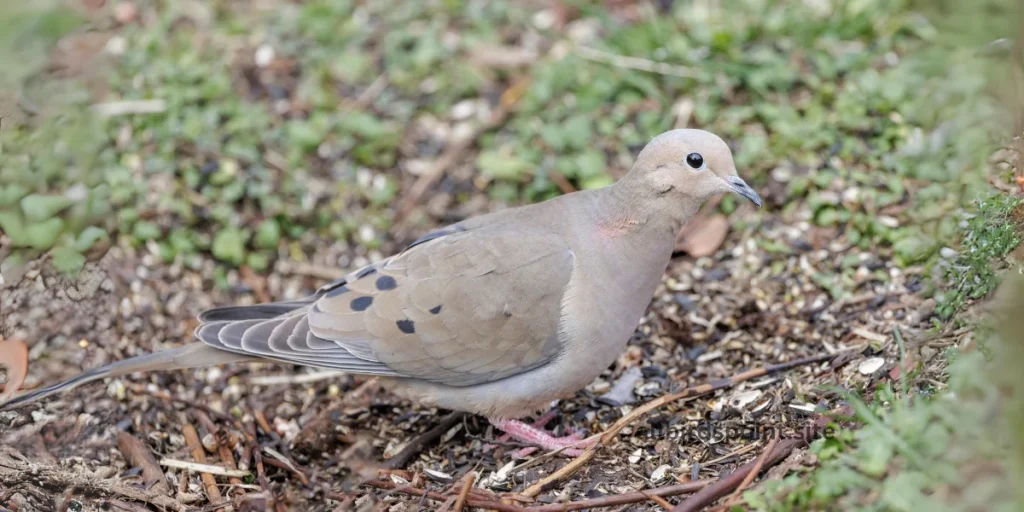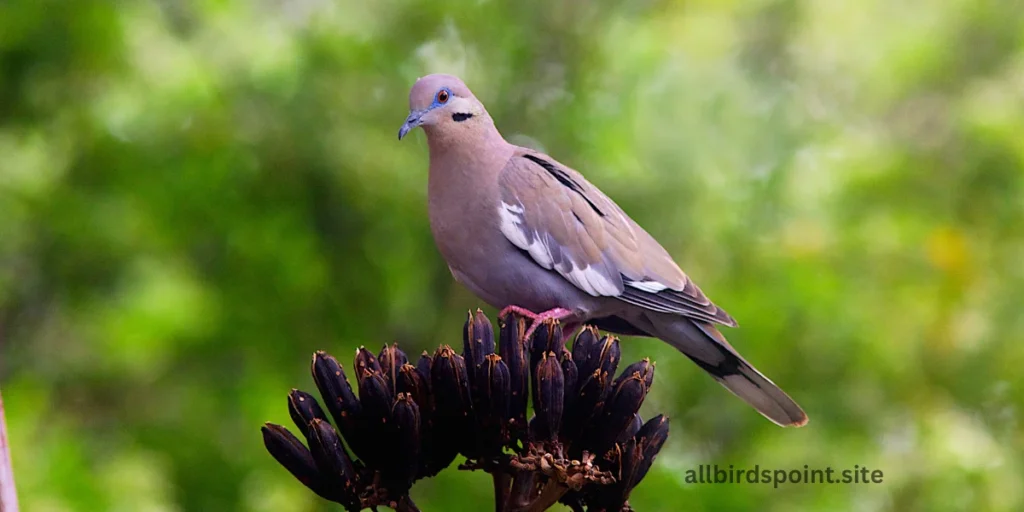Arkansas is home to many beautiful birds, and one of the most loved is the dove. These gentle birds can be found in both cities and the countryside. Doves in Arkansas are often seen flying in the open skies, resting on tree branches, or searching for food in fields. Known for their soft cooing sound, doves bring a peaceful feeling wherever they go. Whether you’re a bird lover or just enjoy the beauty of nature, doves are a common and lovely sight in Arkansas.
4 Types of Doves in Arkansas
- Mourning Dove – The most common, known for its sad coo.
- Eurasian Collared-Dove – Gray with a black neck band.
- White-winged Dove – Has a white wing stripe, found in southern Arkansas.
- Inca Dove – Small with scaly feathers, found in southern areas.
4 Types of Doves in Arkansas Details
Doves are some of the most peaceful and beautiful birds found in Arkansas. Known for their soft cooing and gentle appearance, doves have captured the hearts of bird lovers across the state. Arkansas is home to several species of doves, each with its unique traits and habits. In this detailed article, we will explore four types of doves commonly seen in Arkansas, highlighting their characteristics, behaviors, habitats, and tips on how to identify them.
1. Mourning Dove
Appearance
The Mourning Dove is the most common and recognizable dove species in Arkansas. They have slender, grayish-brown bodies with black spots on their wings. Their tails are long and pointed, with white edges. Mourning Doves are about 9-13 inches in length and have a wingspan of 17-18 inches. Their soft, brown eyes are framed by a thin ring of pale skin.

Behavior
Mourning Doves are known for their peaceful nature. Their name comes from their mournful, sad-sounding cooing, which is often mistaken for a sign of sadness, though it’s simply their way of communicating. These doves are fast fliers, capable of reaching speeds of up to 55 miles per hour. Mourning Doves feed primarily on seeds and grains, which they pick up from the ground. They are commonly seen foraging in fields, parks, and backyards.
Habitat
Mourning Doves can be found in a variety of habitats, including rural areas, cities, and suburban regions. They are highly adaptable and can thrive in open fields, grasslands, and farmlands. They also feel at home in residential gardens and parks, where food is plentiful. Mourning Doves are often spotted perched on telephone wires or fences, keeping an eye out for predators.
Nesting
These doves are frequent nesters and may have up to six broods in a single year. Their nests are simple and made of twigs, usually placed in trees, bushes, or even man-made structures like window ledges or gutters. Mourning Doves lay two eggs per clutch, and both parents take turns incubating the eggs. The young, called squabs, are fed “pigeon milk,” a nutrient-rich substance produced by the parents.
How to Identify a Mourning Dove
- Slender, grayish-brown body with black wing spots
- Long, pointed tail with white edges
- Soft, mournful cooing sound
- Often seen foraging on the ground or perched on wires
| Attribute | Details |
|---|---|
| Scientific Name | Zenaida macroura |
| Average Lifespan | 1.5 – 5 years |
| Size (Length & Wingspan) | 9-13 inches; 17-18 inches |
| Weight | 4-6 oz |
| Color | Grayish-brown with black spots |
| Distinct Features | Long, pointed tail with white edges |
| Common Call | Soft, mournful “coo” |
| Habitat | Open fields, grasslands, gardens |
| Nesting Behavior | Simple twig nests in trees or structures |
| Diet | Seeds and grains |
interesting Facts about Mourning Dove
- Unique Call: The mourning dove’s call is a soft, mournful “coo-coo-coo” that is often associated with peace and tranquility. This distinctive sound can be heard from a distance and is one of the most recognizable bird calls in North America.
- Fast Flyers: Mourning doves are incredibly fast flyers, reaching speeds of up to 55 miles per hour. This speed helps them escape predators and cover large distances in search of food and water.
- Breeding Habits: Mourning doves are known for their rapid breeding cycle. They can produce several broods in a single season, with each brood consisting of two eggs. The young doves, called squabs, are usually ready to leave the nest within 12 to 15 days.
2. Eurasian Collared-Dove
Appearance
The Eurasian Collared-Dove is slightly larger than the Mourning Dove, measuring about 12-14 inches in length with a wingspan of 18-22 inches. They have pale gray feathers, with a slightly pinkish hue on their chest and a distinctive black “collar” or band around the back of their neck. Their tails are square-shaped with white tips, and their wings are broad and rounded.

Behavior
Eurasian Collared-Doves are social birds that can often be found in small groups. They are less shy than Mourning Doves and will approach human-populated areas more readily, especially where food sources are available. Their call is a repetitive “coo-coo-coo,” which is distinct from the softer cooing of the Mourning Dove. These doves feed on seeds, fruits, and grains, and they are also known to visit bird feeders.
Habitat
Originally native to Europe and Asia, Eurasian Collared-Doves were introduced to the United States in the 1980s and have since spread across the country, including Arkansas. They are commonly found in urban and suburban areas, particularly near farms, towns, and residential neighborhoods. They prefer open spaces and can often be seen perched on rooftops, fences, or power lines.
Nesting
Eurasian Collared-Doves build their nests in trees, but they are not as particular as other birds. They will nest in man-made structures if necessary, such as buildings, barns, or even large outdoor planters. Their nests are flimsy, constructed from sticks and twigs, and they lay two eggs per clutch. Like Mourning Doves, both parents share the duty of incubating the eggs and feeding the young.
How to Identify a Eurasian Collared-Dove
- Pale gray feathers with a black collar around the neck
- Larger than Mourning Doves, with a square-shaped tail
- Repetitive “coo-coo-coo” call
- Commonly seen in urban areas and near bird feeders
| Attribute | Details |
|---|---|
| Scientific Name | Streptopelia decaocto |
| Average Lifespan | 3-10 years |
| Size (Length & Wingspan) | 12-14 inches; 18-22 inches |
| Weight | 5-8 oz |
| Color | Pale gray with black collar around neck |
| Distinct Features | Square tail with white tips |
| Common Call | Repetitive “coo-coo-coo” |
| Habitat | Urban and suburban areas, near farms |
| Nesting Behavior | Nests in trees or buildings |
| Diet | Seeds, grains, fruits |
Interesting Facts about Eurasian Collared-Dove
- Invasive Success: Originally native to Asia, the Eurasian collared-dove has become an invasive species in North America. It spread rapidly across the continent after its introduction in the 1980s and is now a common sight in many states, including Arkansas.
- Distinctive Collar: This dove is named for the distinctive black “collar” or crescent-shaped line on the back of its neck. This feature is a key identifying characteristic and gives the bird its name.
- Adaptability: Eurasian collared-doves are highly adaptable and thrive in various habitats, including urban and suburban areas. They can often be seen in city parks, on power lines, and in residential yards.
3. White-winged Dove
Appearance
The White-winged Dove is another species that can be found in parts of Arkansas, especially in the southern regions. As their name suggests, these doves have a distinct white stripe along the edge of their wings, which is visible when they are in flight. Their bodies are light brown or grayish-tan, and they have bright blue rings around their eyes. White-winged Doves are about 11-12 inches in length, with a wingspan of 18-22 inches.

Behavior
White-winged Doves are more common in warmer climates, but they have been steadily expanding their range northward, including into Arkansas. They are strong fliers and often migrate long distances. These doves feed on seeds, grains, and fruits, and they are particularly fond of eating from cacti in desert regions. Like other doves, they are ground feeders and are often seen foraging in fields or gardens.
Their call is a soft “whoo-whoo-whoo,” which is higher-pitched compared to the Mourning Dove.
Habitat
White-winged Doves prefer open woodlands, deserts, and urban areas. In Arkansas, they are more likely to be found in the southern part of the state, where the climate is warmer. They can also be found near water sources, as they need to drink frequently, especially during the hot summer months. These doves are comfortable in both natural and human-altered environments and can often be seen near homes or parks.
Nesting
White-winged Doves build their nests in trees or shrubs, and they may also nest on buildings or other structures. Their nests are made from sticks and are quite flimsy, similar to other dove species. They lay one or two eggs per clutch, and both parents are involved in raising the young. White-winged Doves are known for being excellent parents, often producing multiple broods in a single year.
How to Identify a White-winged Dove
- Light brown or grayish-tan body with a white stripe on the wings
- Bright blue eye rings
- Found mostly in southern Arkansas
- Soft “whoo-whoo-whoo” call
| Attribute | Details |
|---|---|
| Scientific Name | Zenaida asiatica |
| Average Lifespan | 10-15 years |
| Size (Length & Wingspan) | 11-12 inches; 18-22 inches |
| Weight | 4-6 oz |
| Color | Light brown or grayish-tan |
| Distinct Features | White stripe on wings, blue eye rings |
| Common Call | Soft “whoo-whoo-whoo” |
| Habitat | Open woodlands, southern Arkansas |
| Nesting Behavior | Nests in trees or shrubs |
| Diet | Seeds, grains, fruits |
interesting Facts about White-winged Dove
- Southern Spread: The White-winged Dove is native to the southwestern United States and northern Mexico. In recent decades, its range has expanded into southern Arkansas, making it a more common sight in the region.
- Elegant Appearance: White-winged doves are known for their striking appearance, with a distinctive white wing stripe that contrasts with their light brown or grayish-tan body. This feature is particularly visible when the dove is in flight.
- Feeding Habits: These doves are known to feed on a variety of seeds and fruits, including those from cacti. They are especially attracted to crops like millet and sunflower seeds.
4. Inca Dove
Appearance
The Inca Dove is a smaller dove species, measuring about 8 inches in length, making it one of the smallest doves found in Arkansas. They have light gray or tan feathers with a distinctive “scaly” pattern on their wings and backs, which gives them a unique appearance compared to other dove species. Their tails are long and pointed, with white edges.

Behavior
Inca Doves are known for their calm and quiet demeanor. They are often seen in pairs or small groups and are not as social as Eurasian Collared-Doves. They prefer to keep a low profile and are more likely to be found in quieter, less populated areas. These doves feed on seeds, grains, and small insects, and they spend most of their time foraging on the ground.
Habitat
Inca Doves are more commonly found in southern Arkansas, where the climate is warmer. They prefer dry, open areas such as deserts, grasslands, and urban gardens. In colder weather, Inca Doves have a unique behavior where they huddle together in groups to stay warm, forming what is called a “dove pyramid,” with birds stacked on top of one another.
Nesting
Inca Doves build their nests in trees, shrubs, or even on the ground. Their nests are small and flimsy, made of twigs and grasses. They typically lay two eggs per clutch, and both parents take turns incubating the eggs. Inca Doves are known for being quiet and protective parents, raising their young with care.
How to Identify an Inca Dove
- Small size (about 8 inches) with a scaly pattern on feathers
- Long, pointed tail with white edges
- Prefers quiet, dry areas in southern Arkansas
- Often seen foraging on the ground
| Attribute | Details |
|---|---|
| Scientific Name | Columbina inca |
| Average Lifespan | 2-3 years |
| Size (Length & Wingspan) | 8 inches; 12-inch wingspan |
| Weight | 1.5-2 oz |
| Color | Light gray or tan with a scaly pattern |
| Distinct Features | Small size, scaly-looking feathers |
| Common Call | Soft, quiet cooing |
| Habitat | Dry, open areas, southern Arkansas |
| Nesting Behavior | Nests in trees, shrubs, or on the ground |
| Diet | Seeds, grains, small insects |
interesting Facts about Inca Dove
- Smallest Dove: The Inca Dove is one of the smallest dove species in North America, measuring only about 8 inches in length. Its petite size and subtle coloration make it less conspicuous compared to other dove species.
- Scaly Feathers: One of the most notable features of the Inca Dove is its scaly-looking feather pattern on the chest and back. This pattern is unique among doves and gives the bird a textured appearance.
- Preferred Habitat: Inca doves prefer arid and semi-arid habitats, including open woodlands and scrublands. They are well-adapted to dry environments and are often found in areas with sparse vegetation.
Conclusion
Doves are a common and cherished sight in Arkansas, with four distinct species making their home in the state. The Mourning Dove, Eurasian Collared-Dove, White-winged Dove, and Inca Dove each bring their own unique beauty and behaviors to the Arkansas landscape. Whether you’re a birdwatcher or simply enjoy the peaceful presence of these gentle creatures, learning to identify the different types of doves can enhance your appreciation of Arkansas’s rich birdlife.
Next time you’re outdoors, keep an eye out for these doves. You may hear the soft cooing of a Mourning Dove, spot the pale gray feathers of a Eurasian Collared-Dove, or see the distinctive white wing stripes of a White-winged Dove. No matter which species you encounter, doves are sure to bring a sense of calm and beauty to your day.
About Arkansas: A Simple Overview
Arkansas is a state located in the southern part of the United States. Known for its natural beauty and friendly people, it offers a wide range of outdoor activities and attractions. Here’s a straightforward look at what makes Arkansas special:
Geography
- Diverse Landscapes: Arkansas is known for its variety of landscapes. You can find mountains, forests, rivers, and flat plains all within the state. The Ozark Mountains and the Ouachita Mountains are two major mountain ranges here.
- Rivers and Lakes: The state is home to many rivers and lakes, including the Arkansas River and Lake Ouachita. These water bodies provide opportunities for fishing, boating, and other water-related activities.
Climate
- Mild Winters and Warm Summers: Arkansas experiences mild winters with temperatures usually ranging from the 30s to 50s (°F), and hot, humid summers with temperatures often reaching the 80s and 90s (°F).
- Four Seasons: The state has four distinct seasons—spring, summer, fall, and winter—each bringing its own unique weather patterns.
Wildlife
- Abundant Nature: Arkansas is rich in wildlife. You can find various animals like deer, turkey, and bears, as well as many bird species, including doves. The state’s natural habitats support a diverse range of animals and plants.
- Bird Watching: Bird enthusiasts will enjoy Arkansas, as it’s home to many species of birds, including several types of doves.
Cities and Towns
- Little Rock: The capital and largest city in Arkansas. It’s a vibrant city with museums, parks, and cultural attractions.
- Other Cities: Besides Little Rock, other notable cities include Fayetteville, known for its university and outdoor activities, and Hot Springs, famous for its natural hot springs and spas.
Outdoor Activities
- Hiking and Camping: With its many forests and parks, Arkansas is a great place for hiking and camping. Popular spots include the Ozark National Forest and Hot Springs National Park.
- Fishing and Boating: The state’s lakes and rivers are perfect for fishing and boating. Whether you enjoy catching fish or simply relaxing on the water, Arkansas has plenty to offer.
History and Culture
- Rich Heritage: Arkansas has a rich history, with many historical sites and museums that tell the story of the state’s past.
- Cultural Events: The state hosts various cultural events and festivals throughout the year, celebrating everything from music to food.
FAQs
Q: What types of doves are found in Arkansas?
A: Common doves in Arkansas include the Mourning Dove, Eurasian Collared-Dove, White-winged Dove, and Inca Dove.
Q: When is dove hunting season in Arkansas?
A: Dove hunting season typically runs from early September to October, with a second split season in late November or December.
Q: What is the daily bag limit for doves in Arkansas?
A: The daily bag limit is 15 doves per hunter, including all species.
Q: Do I need a special license for dove hunting in Arkansas?
A: Yes, you need a valid Arkansas hunting license and a migratory bird hunting stamp (HIP stamp).
Q: Where are the best places to hunt doves in Arkansas?
A: Ideal spots include agricultural fields, water sources, and public hunting areas like Holland Bottoms WMA and Dagmar WMA.
Q: What is the primary diet of doves in Arkansas?
A: Doves primarily eat seeds and grains, but they also consume small insects and fruits.
